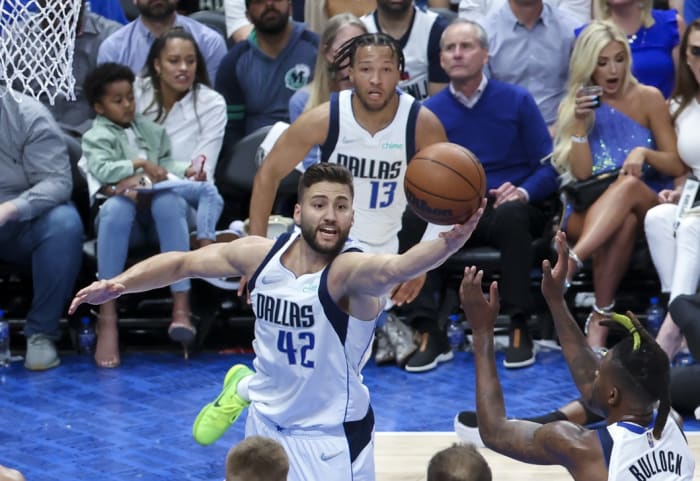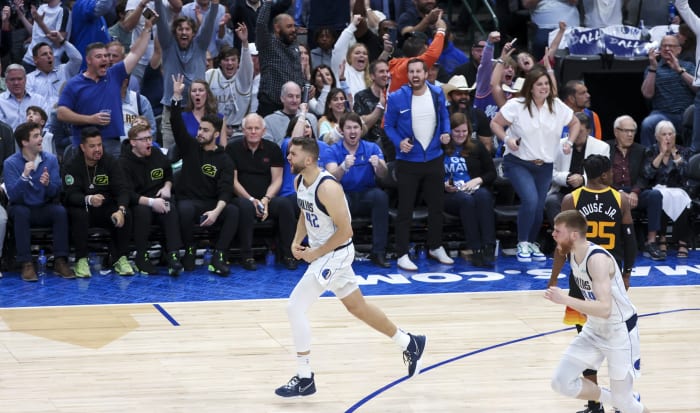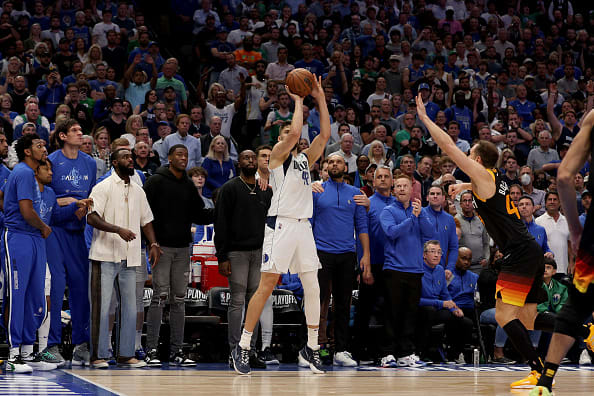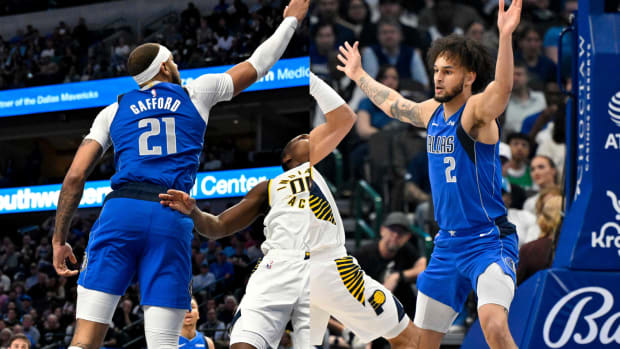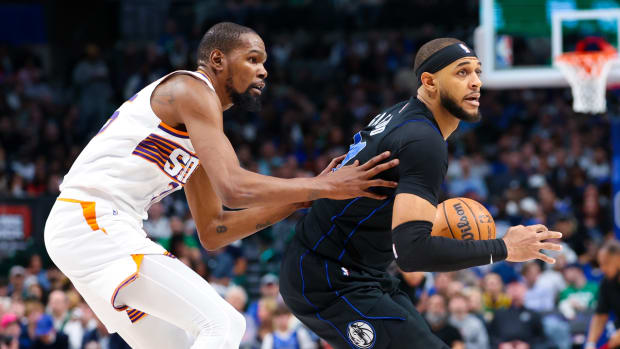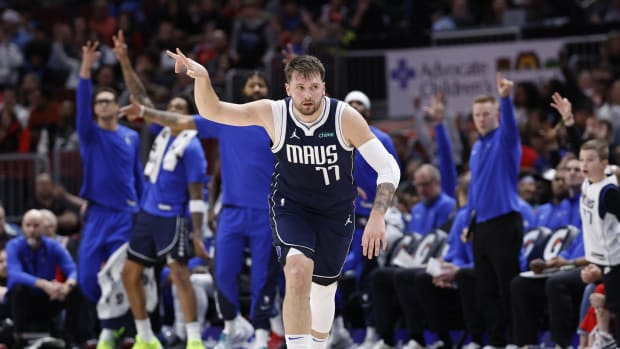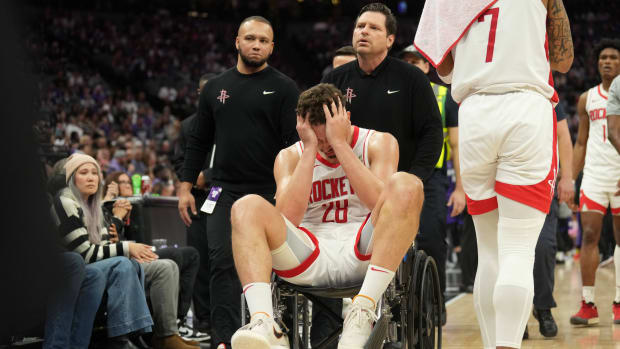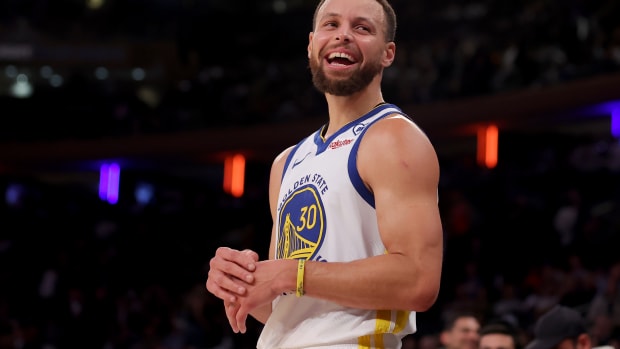Mavs Film Room: Lessons From Game 2 Win
The Dallas Mavericks managed to pull out a 110-103 win over the Utah Jazz in Game 2 to tie the first-round playoff series 1-1.
Without Luka Doncic in the lineup due to a calf strain, the Mavericks needed key players to step up. With Jalen Brunson setting the tone, Dallas got the job done after learning from what went wrong in Game 1.
Here were some key factors that went into the Mavericks' win:
Keep Going Small with Kleber at the 5
The Jazz defense is built around the opposition having at least one non-shooting threat on the court for Rudy Gobert to play off of. Whether it's a traditional big man like Dwight Powell or a wing that is struggling to convert wide-open looks like Josh Green, all it takes is one.
The Mavericks deployed Kleber more at the 5 without a non-shooting threat in the lineup — making the Jazz defense pick between helping on drives or getting blasted on open 3s. Kleber went on to shoot 8-11 (72.7 percent) from 3 in Game 2, while the Mavericks as a team went 22-47 (46.8 percent). Dallas set a single-game playoff franchise record for made 3s. The results were simply staggering.
Whether it was Gobert or Hassan Whiteside, the Jazz's emphasis was to over-help on drives and to stay in drop coverage even if Kleber was involved in the play. Kleber, who shot 18.8 percent from 3 since the All-Star break, made them pay for continuing to stick with their traditional defensive scheme.
The Jazz will be faced with potentially more situations where Gobert is put in a spot having to decide between staying home on Kleber or allowing the underachieving on-ball defenders to attempt to contain a drive on their own.
All the Mavericks need to accomplish with their spacing is to allow a talent like Brunson to get into the paint to operate comfortably. The fourth quarter was a prime display of the results when this happens. Brunson will break down whoever is guarding him and is highly efficient in finishing the play as long as the conditions are suitable.
The Mavericks become able to attack in isolation without having to ball screen — keeping Gobert away from the play as a whole. When he's the low-man, he's at risk of giving up a pass to the weak-side corner by fully committing to help — the main decision Dallas' offense is waiting to make as plays develop.
There's nothing that exposes the weaknesses of a roster quite like the gradual chess match of a playoff series. The Jazz's lack of on-ball defense was exposed to an extreme level without Doncic even being on the court.
Brunson, Mavericks Made Meaningful Adjustments
The Jazz had a tough time containing Brunson throughout Game 2 and that's pretty clear given he finished with 41 points. A critical element to his success was newfound aggression from beyond the arc, as he shot 6-10 on the night.
A theme in Game 1 from the Jazz defense was their approach to go under screens and handoffs against Brunson. There were situations when the best outcome surely would have been to take a pull-up to counter, but he instead dribbled into a tougher shot inside the 3-point line or simply missed the pull-up 3.
There was a clear emphasis from Brunson to make the Jazz pay for going under against him. Early in the first quarter, he threaded consecutive pull-up 3s — one coming after receiving a handoff out of the corner and the other in a high ball screen. These were not outcomes occurring in Game 1.
Brunson had a lot of confidence from deep early on and it was clear he was seeking out chances to get his shot off. There was a possession also in the opening period that featured Donovan Mitchell sagging way off Brunson instead of engaging tightly to stop the ball — leaving the Jazz vulnerable to another pull-up 3.
One of the key indicators of the value of establishing oneself as a deep threat was Brunson's pull-up 3 in transition. The hesitation moves that Brunson is so savvy with using become all the more impactful when the on-ball defender fears the pull-up 3. Mitchell got blown by often because of this.
One of the complications the Mavericks faced in Game 1 was the disruptions caused by Gobert when he was locking down the paint. With Powell on the floor, Brunson still had to account for a shot-blocker as the big defender in ball screening situations and as a help defender out of the dunker's spot. So what changed?
Early in Game 2, instead of trying to attack from the top of the key in a high ball screen, the Mavericks made the adjustment to going empty corner and allowing Brunson to have a full side of the court to attack. Royce O'Neale was simply unable to keep up with Brunson's shiftiness and did not have meaningful help.
The Mavericks deployed a plug-and-play lineup in the second quarter that featured all shooting threats — creating a prime opportunity for Brunson to attack his man off-the-dribble to get to the rim. As Gobert had to account for Finney-Smith spacing out from the corner, he was unable to make his presence felt in the paint. This proved to be a preview of what was to come toward the end of the game.
Another intriguing approach from Brunson and the Mavericks' offense came in the second quarter using a ball screen with Powell as the screener. With the Jazz seeking to ice ball screens to deny the use of the screen to go middle, Whiteside had to play up to prevent a pull-up 3 but recovered back to Powell to prevent a pass on the roll.
With the rest of the Jazz defense staying home on shooters, Brunson knew he had a clean driving lane to get to a floater after sealing House Jr. on his hip early. It became a matter of Brunson attacking the on-ball defender without there being meaningful help in a position to pressure him.
Brunson did most of his damage in the third quarter using the two-man game with Powell despite Gobert being the big defender. They kicked things off with a handoff that drew O'Neale to go over — creating a hostage dribble opportunity for Brunson to get to his floater in the gap. Using more handoffs against drop coverage could be an appealing option going forward.
Perhaps one of the best indicators of Brunson's game-by-game progression early in this series was the shot creation sequences he had in the third quarter. He wasn't just raising up to shoot against an on-ball defender going under a ball screen. Instead, he used a high-level approach to create a clean look from deep.
In one of these plays, Brunson rejected a ball screen from Powell after selling O'Neale that he was going to use the screen. Once O'Neale committed his body angle to navigate the ball screen, Brunson countered with a push crossover to get into open space behind the 3-point line for the pull-up.
With O'Neale going over the ball screen, Brunson knew if he snaked the ball screen he could get back behind the 3-point line for a pull-up. It was all made possible by Gobert engaging in a deep drop to seal off the paint. Brunson was not seeking out pull-up 3s like this in Game 1 and it changes the offense significantly when he does.
The fourth quarter became a focus on going small to give Brunson the space to attack favorable matchups in isolation situations. The Mavericks used a few ball screens using a wing to draw a switch knowing the Jazz will look to switch 1-4. Whether it was Mike Conley or Bojan Bogdanovic, Brunson shifted them off the bounce while Gobert was unable to impact in help.
When Brunson began a possession with Jordan Clarkson as the on-ball defender attempting to stop the ball, he got aggressive quickly to get to the rim. It shows a clear formula for success; don't hesitate against a favorable matchup, but use a wing screener to draw a switch to attack a weak point when needed.
The way Brunson handled initiating the offense displayed legitimate star qualities. He countered various approaches the Jazz deployed and executed at a high level. However, what makes a star is consistently achieving those results. How he performs in Game 3 could be quite telling.
Patience is Key for Dinwiddie
Overall, it's been a struggle for Dinwiddie to score at an efficient rate through two games. The Jazz have largely succeeded in defending Dinwiddie within the half-court. He's struggled to convert on pull-up jumpers with how Utah has gone under screens, and with there typically being a rim protector in the paint, it's been awkward at times for him to get deep on a drive to make a play.
What has worked for Dinwiddie has been drawing one of the Jazz bigs on a switch, retreating out to space, then blowing by them to get to the rim. While there's a great debate about Gobert's on-ball defense on switches, all that matters is neither he nor Whiteside can stay in front of Dinwiddie.
Another option that worked for the Mavericks was using shooting threats as ball screeners to draw a switch for Dinwiddie to attack. Getting aggressive against an underwhelming on-ball defender like Clarkson or Mitchell by seeking them out on switches has been quite helpful.
It will help Dinwiddie significantly when Doncic is back in the lineup. He can revert back to coming off the bench and attacking within the flow of the offense when deployed in plug-and-play lineup combinations alongside Doncic. The spot-up looks will be there from 3-point range, but so will these attacks off the catch.
Even when Dinwiddie is struggling to produce, he's been able to make timely plays. It's important to have multiple threats on the floor that can break down a defender out in space to get into the paint. With Doncic sidelined, that presence has helped take some pressure off Brunson.
Conley, Gobert Costing Jazz
The Jazz received some respectable scoring performances in Game 2 from some of their top options. Donovan Mitchell finished with 34 points and did so while producing a solid 1.03 points per possession — improved from his less efficient Game 1 outing.
Mitchell received quite a bit of help from two of his teammates in particular. Bogdanovic (25) and Clarkson (21) combined for 46 points with great efficiency. When looking at them as a trio, there were 80 total points. The rest of the unit was underwhelming and it proved to be costly.
The weak points in the Jazz offense consisted of Conley along with their bigs. Conley went scoreless in 22 minutes, while Gobert and Whiteside combined for 10 points while producing just 0.67 points per possession. Keeping the top options in check just enough is key when the rest of the unit is underachieving this much.
While the Jazz on-ball defenders deserve criticism for being unable to contain dribble penetration, Gobert deserves to catch heat for being so unskilled with the basketball to where teams can feel they can get away with going small. In fact, it goes further; it's an advantage for teams to go small if he's going to get touches.
When given the ball as a rim roller outside of a lob at the rim, Gobert turned the ball over a few times. The Mavericks deployed Brunson as the low-man — something that would be punished if Joel Embiid or Nikola Jokic were on the roll. Instead, Brunson swiped the ball away from Gobert on one sequence, while a poor pass from Gobert with Dinwiddie guarding 2-with-1 was intercepted on another.
Perhaps most telling was the post touch Gobert received against Kleber on the block that ended in him attempting to drop step but instead dribbling it off his leg. Again, Kleber could try to hold his own against a talent like Embiid or Jokic on the block, but at some point, sending help or getting more size out there would be needed.
The Jazz are unable to trust Gobert as a finisher when there is a defender in position to meet him on a deep catch on a roll. It makes it challenging to trust him to execute when he slips on a screen since he's likely going to face a defender waiting to pressure his finish.
There were shortcomings involving Gobert even on lob passes from Mitchell in ball-screening situations. They connected successfully in a high ball screen where Mitchell snaked into the gap to draw Powell on the step up. On the other lobs, Mitchell was launching a pass quickly after dribbling off the pick and was unable to connect.
As for Conley, he's been limited to mostly attacking in ball screen situations and he's often been unsuccessful. The Mavericks understand that he wants to get to his right-hand floater when he gets downhill, so they've made it a point to load up on his side before he gets it off.
Conley has also failed to capitalize as a shot creator, mostly from the 3-point line. With how the Mavericks have prioritized taking away spot-up attempts, the Jazz need pull-ups and step-backs to drop at a reasonable clip, but Conley has been underwhelming on his chances.
The Jazz sorely need their highly paid veteran role players to execute when the offense turns to them to make a play. The focus of the Mavericks' defense has been to slow down Mitchell and he needs his complementary talents to take pressure off of him. Within the flow, Bogdanovic and Clarkson have stepped, but that's about as far as it has gone.
